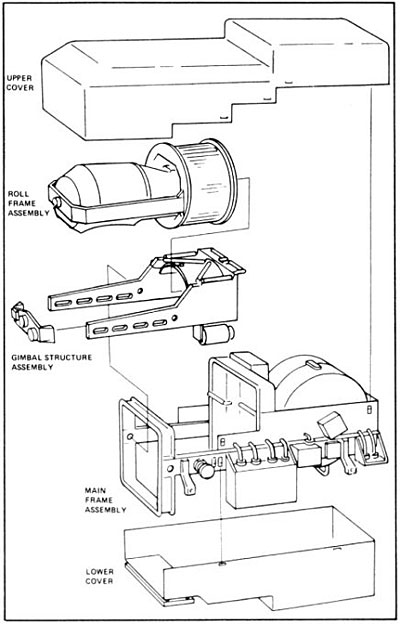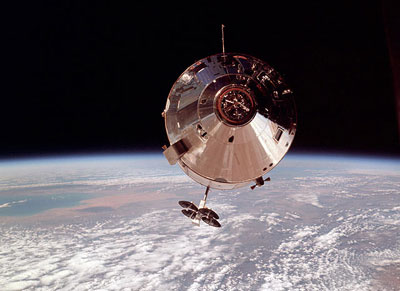Making lemons into lemonadeby Dwayne Day
|
| NASA officials sought to find other things that a crew could do so that the mission was not a complete waste. They wanted to take their lemons and make lemonade. |
But Caidin was onto something. Of course everybody knows about the drama of Apollo 13 in 1970. NASA officials, though, tried to plan for every possible failure that could happen during an Apollo mission. Some of the failures might not even be catastrophic—“mission failures” rather than crew fatalities. One such possibility might be the Saturn rocket’s third stage engine not firing to take the crew to the Moon. In that case the spacecraft would be restricted to Earth orbit. The crew could still return, but they could not perform their primary mission. NASA officials sought to find other things that a crew could do so that the mission was not a complete waste. They wanted to take their lemons and make lemonade. Surprisingly, one of the things they did was plan to conduct reconnaissance operations in Earth orbit.
Starting at least as early as spring 1970 for the Apollo 13 mission, NASA began planning for what it referred to as “Earth Orbital Contingency” missions. The agency concluded that there were few useful things other than taking photographs that the astronauts could do in Earth orbit. They therefore prepared contingency photographic missions for Apollo 13, 14, 15, and presumably later missions.
In May 1971, Apollo Program Director Rocco Petrone wrote his boss, Dale Myers, the Associate Administrator for Manned Space Flight, about the Apollo 15 Contingency Mission planning. Petrone explained that with Apollo 15, the spacecraft would be carrying a couple of cameras that would be useful for Earth photography. These were a 3-inch (7.6-centimeter) focal length stellar-index mapping camera, and a 24-inch (60-centimeter) focal length panoramic camera manufactured by Itek. The panoramic camera was adapted from the KA-80A reconnaissance camera then in use by the Air Force aboard the SR-71 Blackbird spyplane. The KA-80A was itself adapted from a camera developed for the Corona reconnaissance spacecraft and used some of the same lenses.
 An illustration of the Apollo Panoramic Camera. (credit: NASA) |
Petrone explained that because the Itek camera was designed for operating 60–80 nautical miles (110–150 kilometers) above the Moon, it was equipped to provide forward motion compensation for the images that it took. This required the Apollo spacecraft to operate in a 230-nautical-mile (425-kilometer) Earth orbit. The orbital inclination would be increased to 40 degrees. The astronauts would also optimize the orbit to obtain good solar illumination over the United States.
The details on the quality of the photography from such an orbit are deleted from the declassified document. However, given that the camera was roughly equivalent to the Corona spysat, which could produce roughly six-foot (two-meter) resolution on the ground, the Apollo spacecraft would have been no better than this, and probably in the range of 25–30 feet (7.6–9.1 meters) due to the higher orbit and other factors. Petrone noted that aerial cameras were normally equipped with filters to eliminate haze and blue scattered light that could degrade system performance. The Apollo Panoramic Camera lacked such a filter and this would therefore degrade the camera performance.
Soon after Petrone wrote his memo, NASA Administrator James C. Fletcher wrote a letter to Henry Kissinger, Richard Nixon’s national security advisor and then the most powerful foreign policy official in the United States, explaining the contingency plan. Fletcher explained that this contingency plan “would offer a unique opportunity to acquire earth survey photography in support of the NASA Earth Resources Survey Program,” and would be restricted to covering only United States territory. (The memos can be downloaded here.)
The memos don’t explain an important fact: that any such mission would probably result in unwanted attention to the United States’ spy satellite program. After all, the photographs would be released and would reveal significant detail, prompting people to assume that similarly detailed photographs already existed of America’s adversaries.
The National Reconnaissance Office, which ran the United States’ satellite reconnaissance program, had already taken efforts to avoid embarrassment by NASA astronauts. Beginning with the Gemini missions, the National Photographic Interpretation Center, which analyzed spy satellite photography, had reviewed the photographs produced by the astronauts to make sure that they did not reveal sensitive information—like the existence of the secret test facilities at Groom Lake, aka Area 51. But handheld cameras on the Gemini and early Apollo missions were incapable of producing good quality ground photography. The Apollo Panoramic Camera was far more powerful.
| The memos don’t explain an important fact: that any such mission would probably result in unwanted attention to the United States’ spy satellite program. |
Fortunately, Apollos 15 through 17 flew without a hitch. But the problem never went away. Only two years later, as NASA prepared to launch Skylab into orbit, the agency sought approval from the top secret “40 Committee,” which oversaw approval of satellite and aircraft reconnaissance missions, to fly the Earth Terrain Camera, which had a resolution of 10 to 20 meters. Although not as good as the Apollo Panoramic Camera—which was never used in Earth orbit—this was substantially better than any previously produced civilian imagery of the Earth. What further complicated the issue was that NASA would be taking pictures of non-American territory, possibly including some areas of the Soviet Union and China.
Donald H. Steininger, the CIA’s Assistant Deputy Director for Science and Technology, wrote a long memorandum to his boss, the Director of Central Intelligence, explaining the situation. Although Steininger recommended that they approve NASA’s request, he also suggested that the policy implications of releasing imagery of foreign territory be discussed within the intelligence community. Such a release, he warned, could result in challenges to the United States’ current program for conducting satellite reconnaissance. The issues were complex and required coordination between agencies—and of course the opinion of many within the American intelligence community was that they wanted the whole issue to go away. The last thing they wanted was more attention on American reconnaissance capabilities and operations. (The memo can be downloaded here.)
NASA strove to operate in the open as much as possible, and occasionally its actions got close to those of agencies that chose to operate in the dark as much as possible. The intelligence community had to try to make lemonade out of the lemons that the space agency was dealing them. It was not an inherently exciting situation, but it seems likely that Martin Caidin probably could have found some drama in it.
